Human Resource Management Report: HRM in Hilton Hotels and Resorts
VerifiedAdded on 2019/12/28
|11
|2994
|108
Report
AI Summary
This report provides a detailed analysis of Human Resource Management (HRM) practices, focusing on Hilton Hotels and Resorts. It begins with an introduction to HRM and differentiates between personnel and human resource management. The report explores the process and significance of Human Resource Planning (HRP), comparing recruitment and selection processes between Hilton and Marriott Hotels. It examines the relationship between motivational theory and reward systems, the job evaluation process, and other factors for pay determination. The effectiveness of the reward system in Hilton Hotels is evaluated, along with methods for evaluating performance and reasons for employment cessation. The report also covers procedures for employment exit and the effects of the regulatory framework on employment cessation. The report concludes with a summary of the key findings and references.
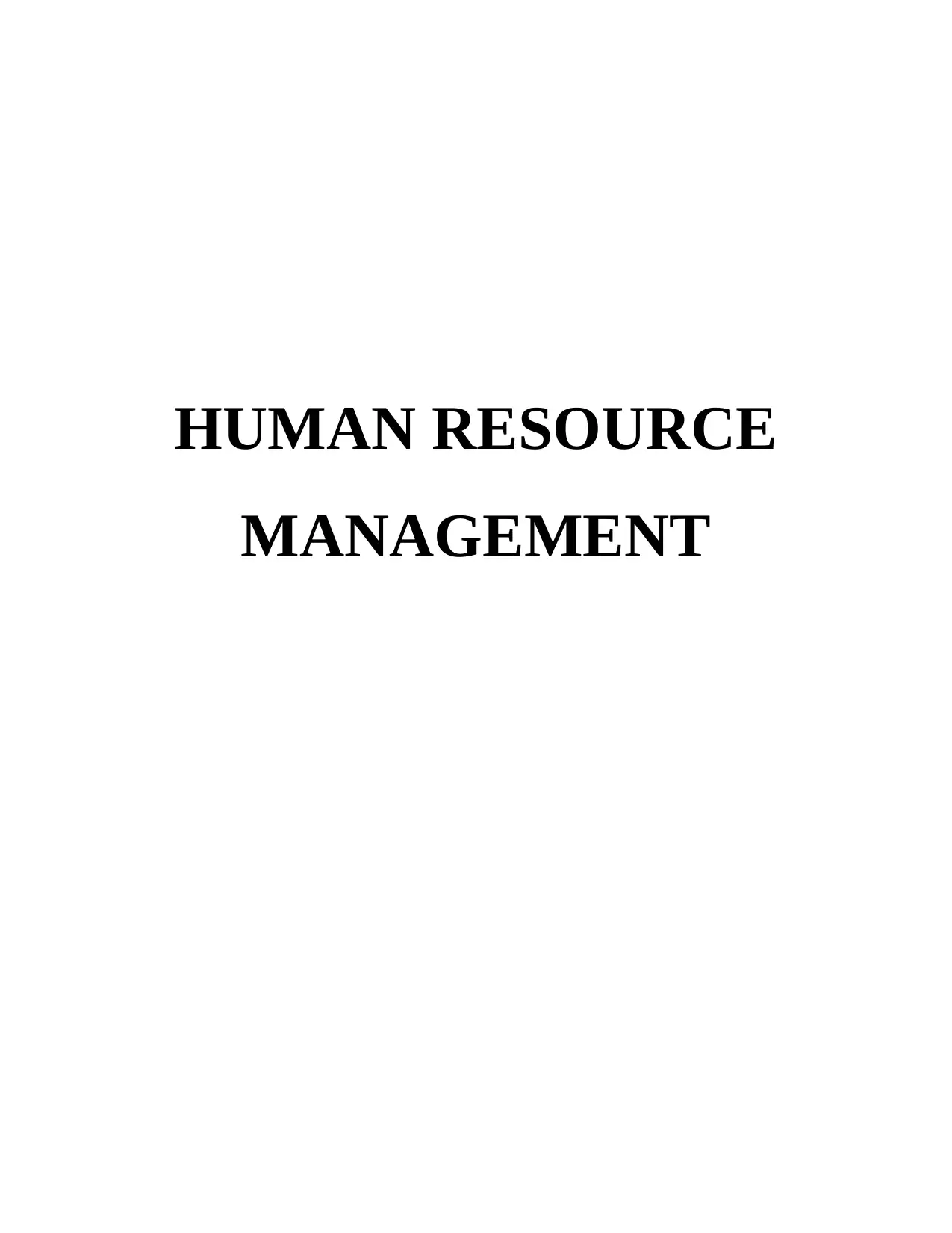
HUMAN RESOURCE
MANAGEMENT
MANAGEMENT
Paraphrase This Document
Need a fresh take? Get an instant paraphrase of this document with our AI Paraphraser
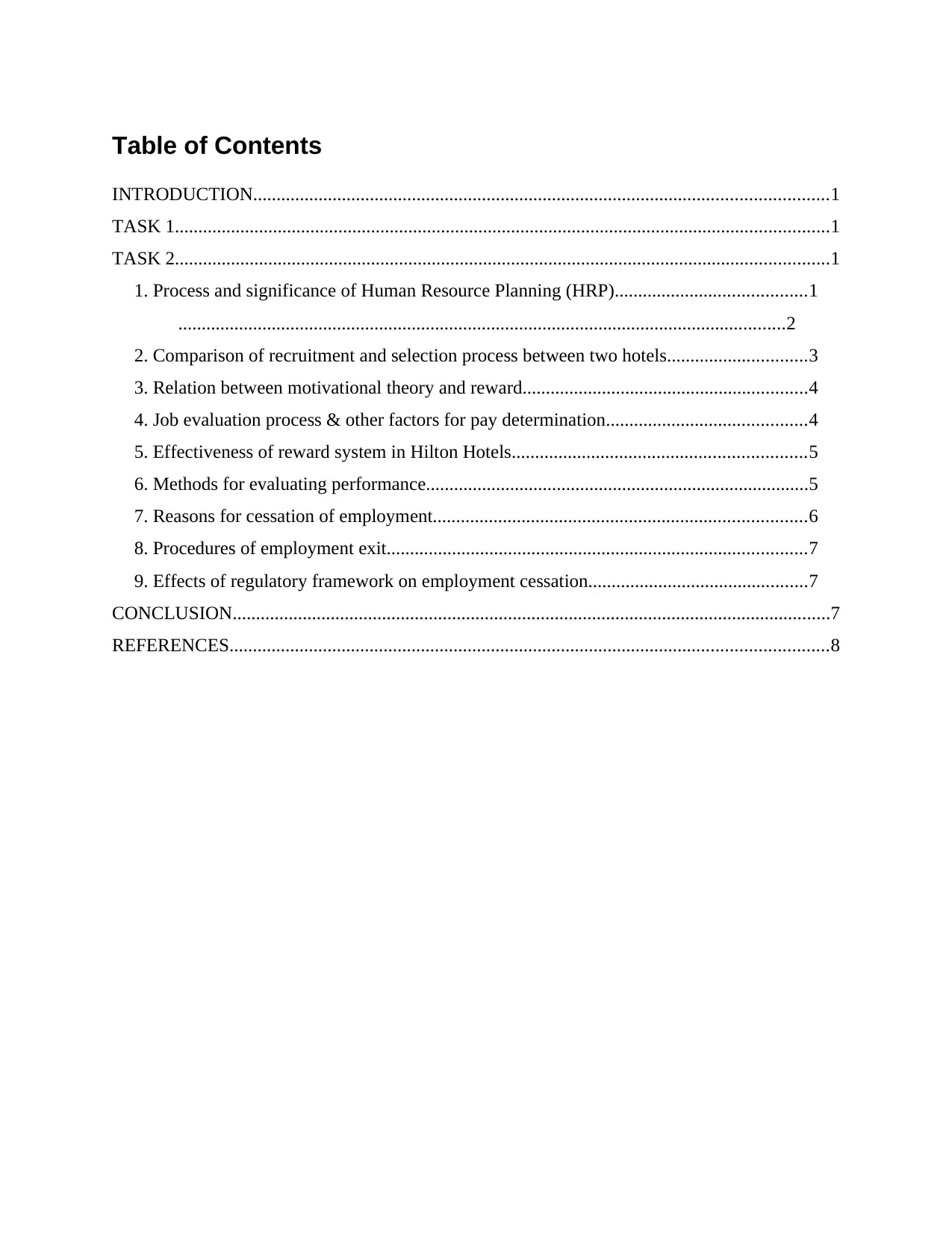
Table of Contents
INTRODUCTION...........................................................................................................................1
TASK 1............................................................................................................................................1
TASK 2............................................................................................................................................1
1. Process and significance of Human Resource Planning (HRP).........................................1
..................................................................................................................................2
2. Comparison of recruitment and selection process between two hotels..............................3
3. Relation between motivational theory and reward.............................................................4
4. Job evaluation process & other factors for pay determination...........................................4
5. Effectiveness of reward system in Hilton Hotels...............................................................5
6. Methods for evaluating performance..................................................................................5
7. Reasons for cessation of employment................................................................................6
8. Procedures of employment exit..........................................................................................7
9. Effects of regulatory framework on employment cessation...............................................7
CONCLUSION................................................................................................................................7
REFERENCES................................................................................................................................8
INTRODUCTION...........................................................................................................................1
TASK 1............................................................................................................................................1
TASK 2............................................................................................................................................1
1. Process and significance of Human Resource Planning (HRP).........................................1
..................................................................................................................................2
2. Comparison of recruitment and selection process between two hotels..............................3
3. Relation between motivational theory and reward.............................................................4
4. Job evaluation process & other factors for pay determination...........................................4
5. Effectiveness of reward system in Hilton Hotels...............................................................5
6. Methods for evaluating performance..................................................................................5
7. Reasons for cessation of employment................................................................................6
8. Procedures of employment exit..........................................................................................7
9. Effects of regulatory framework on employment cessation...............................................7
CONCLUSION................................................................................................................................7
REFERENCES................................................................................................................................8
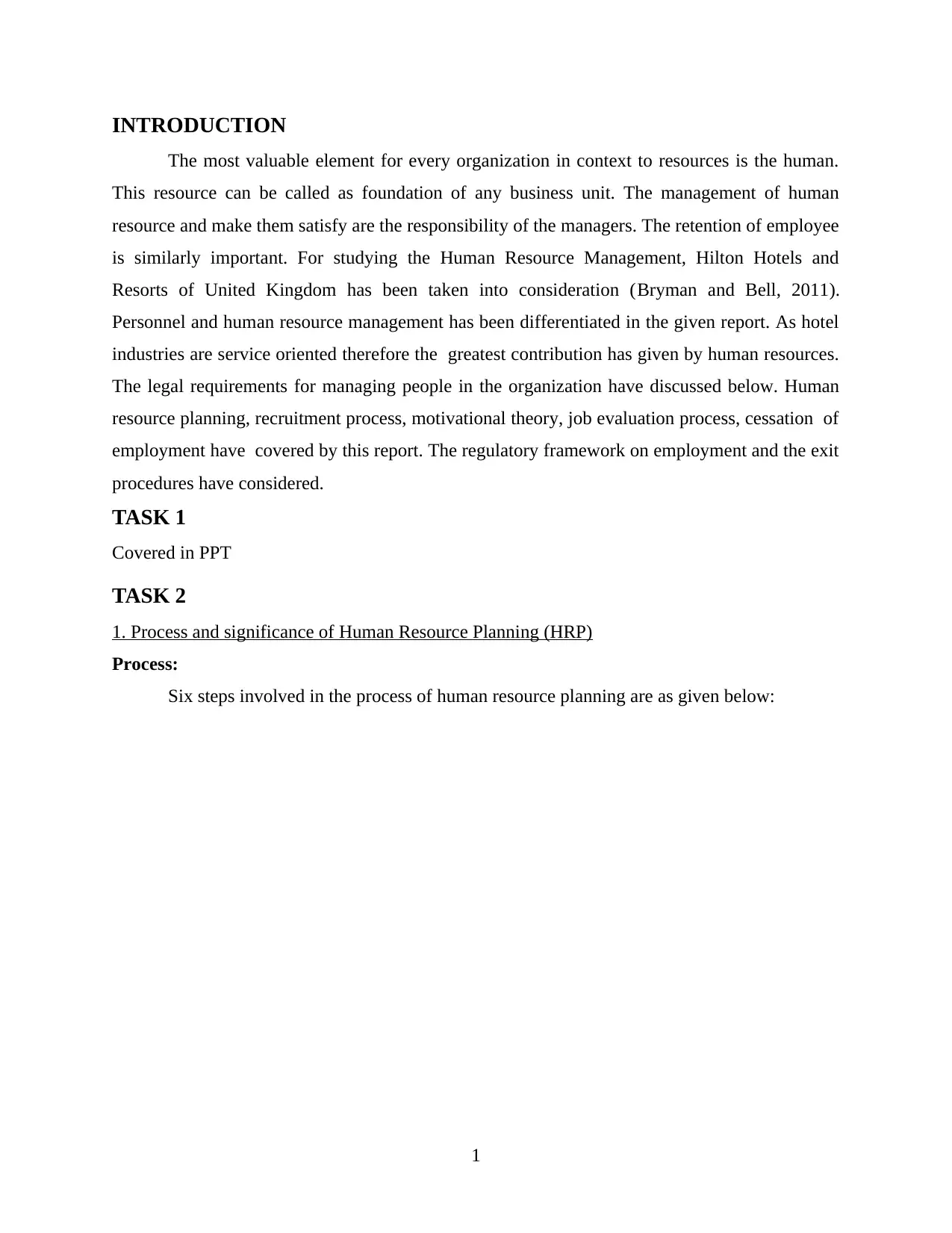
INTRODUCTION
The most valuable element for every organization in context to resources is the human.
This resource can be called as foundation of any business unit. The management of human
resource and make them satisfy are the responsibility of the managers. The retention of employee
is similarly important. For studying the Human Resource Management, Hilton Hotels and
Resorts of United Kingdom has been taken into consideration (Bryman and Bell, 2011).
Personnel and human resource management has been differentiated in the given report. As hotel
industries are service oriented therefore the greatest contribution has given by human resources.
The legal requirements for managing people in the organization have discussed below. Human
resource planning, recruitment process, motivational theory, job evaluation process, cessation of
employment have covered by this report. The regulatory framework on employment and the exit
procedures have considered.
TASK 1
Covered in PPT
TASK 2
1. Process and significance of Human Resource Planning (HRP)
Process:
Six steps involved in the process of human resource planning are as given below:
1
The most valuable element for every organization in context to resources is the human.
This resource can be called as foundation of any business unit. The management of human
resource and make them satisfy are the responsibility of the managers. The retention of employee
is similarly important. For studying the Human Resource Management, Hilton Hotels and
Resorts of United Kingdom has been taken into consideration (Bryman and Bell, 2011).
Personnel and human resource management has been differentiated in the given report. As hotel
industries are service oriented therefore the greatest contribution has given by human resources.
The legal requirements for managing people in the organization have discussed below. Human
resource planning, recruitment process, motivational theory, job evaluation process, cessation of
employment have covered by this report. The regulatory framework on employment and the exit
procedures have considered.
TASK 1
Covered in PPT
TASK 2
1. Process and significance of Human Resource Planning (HRP)
Process:
Six steps involved in the process of human resource planning are as given below:
1
⊘ This is a preview!⊘
Do you want full access?
Subscribe today to unlock all pages.

Trusted by 1+ million students worldwide
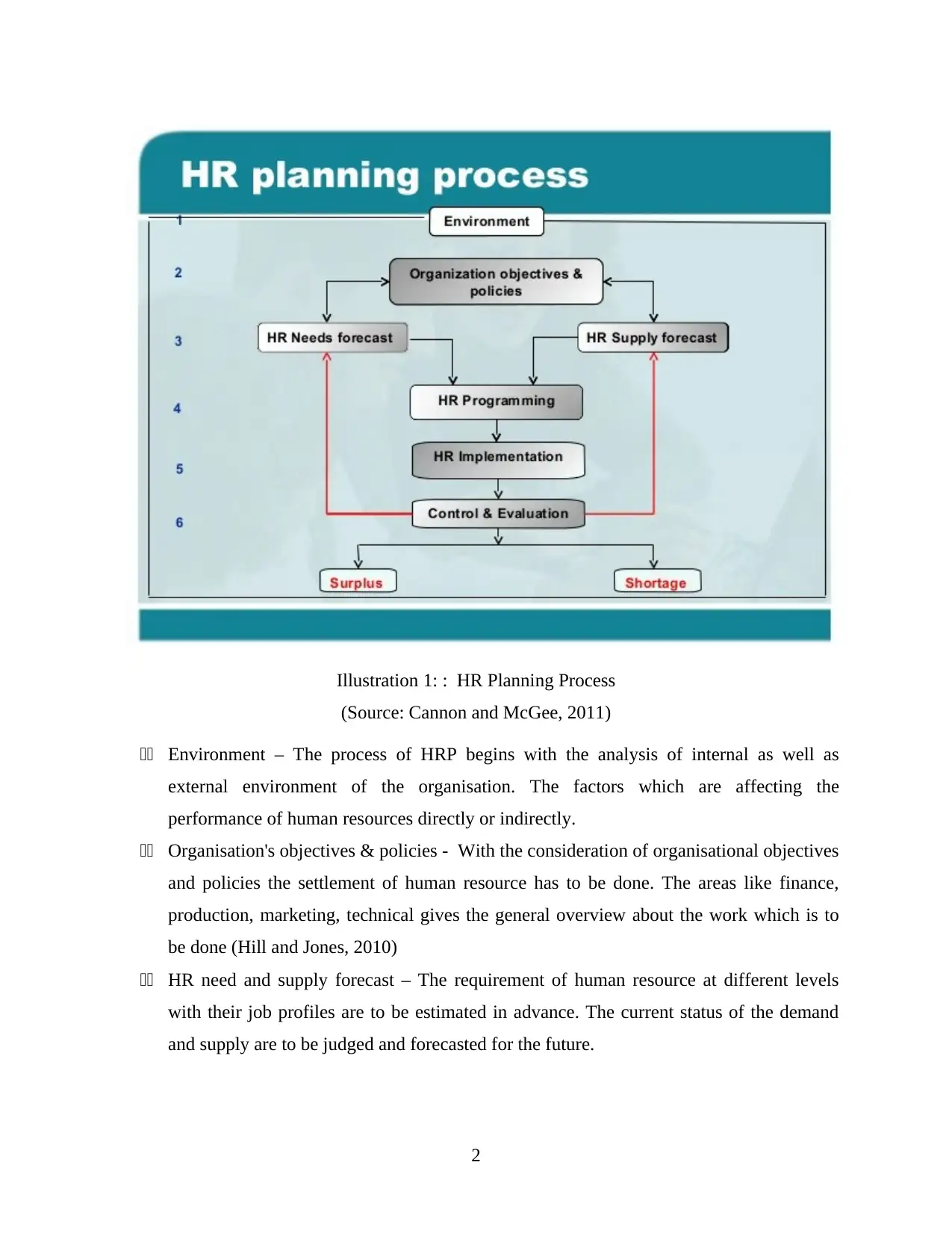
Illustration 1: : HR Planning Process
(Source: Cannon and McGee, 2011)
11 Environment – The process of HRP begins with the analysis of internal as well as
external environment of the organisation. The factors which are affecting the
performance of human resources directly or indirectly.
11 Organisation's objectives & policies - With the consideration of organisational objectives
and policies the settlement of human resource has to be done. The areas like finance,
production, marketing, technical gives the general overview about the work which is to
be done (Hill and Jones, 2010)
11 HR need and supply forecast – The requirement of human resource at different levels
with their job profiles are to be estimated in advance. The current status of the demand
and supply are to be judged and forecasted for the future.
2
(Source: Cannon and McGee, 2011)
11 Environment – The process of HRP begins with the analysis of internal as well as
external environment of the organisation. The factors which are affecting the
performance of human resources directly or indirectly.
11 Organisation's objectives & policies - With the consideration of organisational objectives
and policies the settlement of human resource has to be done. The areas like finance,
production, marketing, technical gives the general overview about the work which is to
be done (Hill and Jones, 2010)
11 HR need and supply forecast – The requirement of human resource at different levels
with their job profiles are to be estimated in advance. The current status of the demand
and supply are to be judged and forecasted for the future.
2
Paraphrase This Document
Need a fresh take? Get an instant paraphrase of this document with our AI Paraphraser
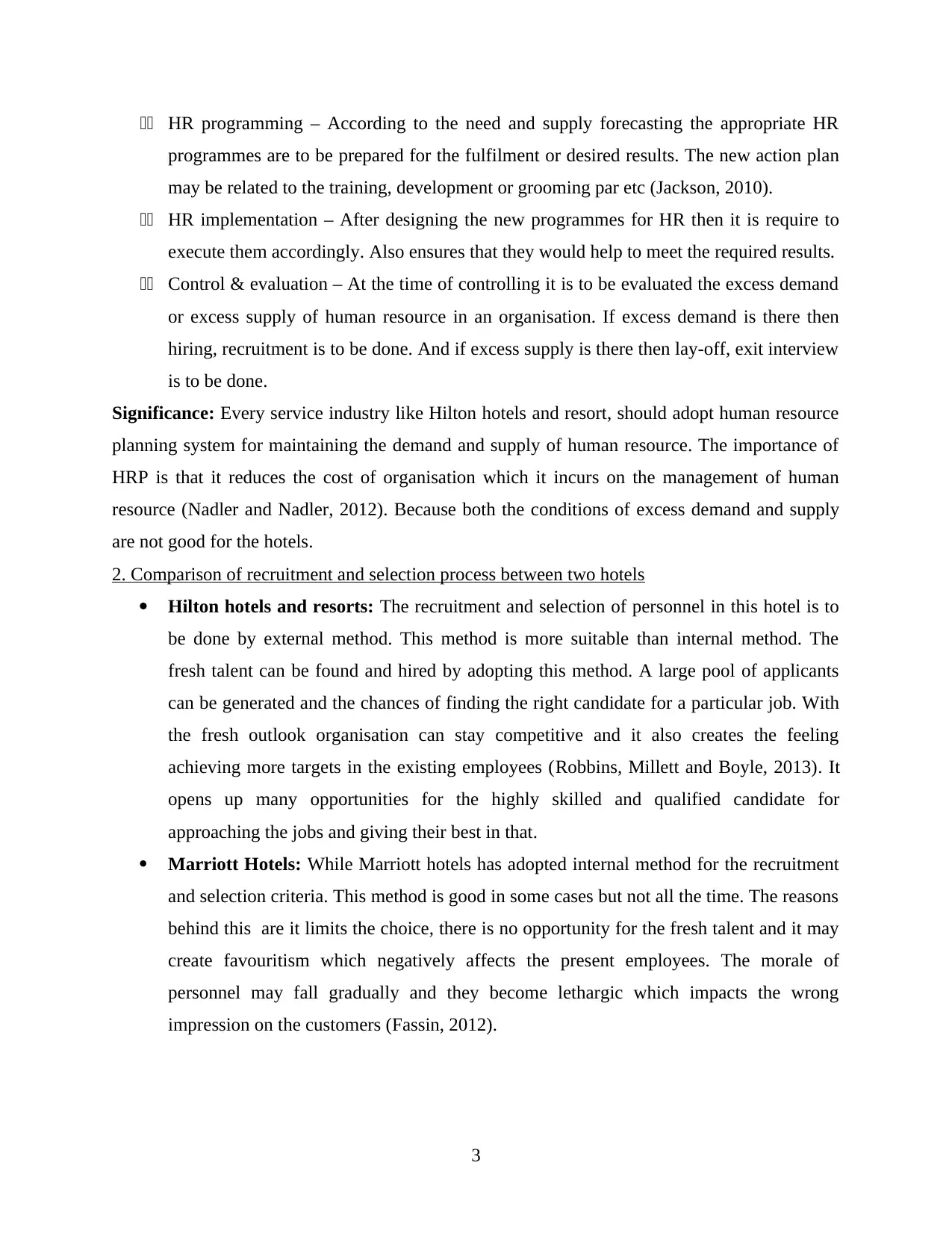
11 HR programming – According to the need and supply forecasting the appropriate HR
programmes are to be prepared for the fulfilment or desired results. The new action plan
may be related to the training, development or grooming par etc (Jackson, 2010).
11 HR implementation – After designing the new programmes for HR then it is require to
execute them accordingly. Also ensures that they would help to meet the required results.
11 Control & evaluation – At the time of controlling it is to be evaluated the excess demand
or excess supply of human resource in an organisation. If excess demand is there then
hiring, recruitment is to be done. And if excess supply is there then lay-off, exit interview
is to be done.
Significance: Every service industry like Hilton hotels and resort, should adopt human resource
planning system for maintaining the demand and supply of human resource. The importance of
HRP is that it reduces the cost of organisation which it incurs on the management of human
resource (Nadler and Nadler, 2012). Because both the conditions of excess demand and supply
are not good for the hotels.
2. Comparison of recruitment and selection process between two hotels
Hilton hotels and resorts: The recruitment and selection of personnel in this hotel is to
be done by external method. This method is more suitable than internal method. The
fresh talent can be found and hired by adopting this method. A large pool of applicants
can be generated and the chances of finding the right candidate for a particular job. With
the fresh outlook organisation can stay competitive and it also creates the feeling
achieving more targets in the existing employees (Robbins, Millett and Boyle, 2013). It
opens up many opportunities for the highly skilled and qualified candidate for
approaching the jobs and giving their best in that.
Marriott Hotels: While Marriott hotels has adopted internal method for the recruitment
and selection criteria. This method is good in some cases but not all the time. The reasons
behind this are it limits the choice, there is no opportunity for the fresh talent and it may
create favouritism which negatively affects the present employees. The morale of
personnel may fall gradually and they become lethargic which impacts the wrong
impression on the customers (Fassin, 2012).
3
programmes are to be prepared for the fulfilment or desired results. The new action plan
may be related to the training, development or grooming par etc (Jackson, 2010).
11 HR implementation – After designing the new programmes for HR then it is require to
execute them accordingly. Also ensures that they would help to meet the required results.
11 Control & evaluation – At the time of controlling it is to be evaluated the excess demand
or excess supply of human resource in an organisation. If excess demand is there then
hiring, recruitment is to be done. And if excess supply is there then lay-off, exit interview
is to be done.
Significance: Every service industry like Hilton hotels and resort, should adopt human resource
planning system for maintaining the demand and supply of human resource. The importance of
HRP is that it reduces the cost of organisation which it incurs on the management of human
resource (Nadler and Nadler, 2012). Because both the conditions of excess demand and supply
are not good for the hotels.
2. Comparison of recruitment and selection process between two hotels
Hilton hotels and resorts: The recruitment and selection of personnel in this hotel is to
be done by external method. This method is more suitable than internal method. The
fresh talent can be found and hired by adopting this method. A large pool of applicants
can be generated and the chances of finding the right candidate for a particular job. With
the fresh outlook organisation can stay competitive and it also creates the feeling
achieving more targets in the existing employees (Robbins, Millett and Boyle, 2013). It
opens up many opportunities for the highly skilled and qualified candidate for
approaching the jobs and giving their best in that.
Marriott Hotels: While Marriott hotels has adopted internal method for the recruitment
and selection criteria. This method is good in some cases but not all the time. The reasons
behind this are it limits the choice, there is no opportunity for the fresh talent and it may
create favouritism which negatively affects the present employees. The morale of
personnel may fall gradually and they become lethargic which impacts the wrong
impression on the customers (Fassin, 2012).
3
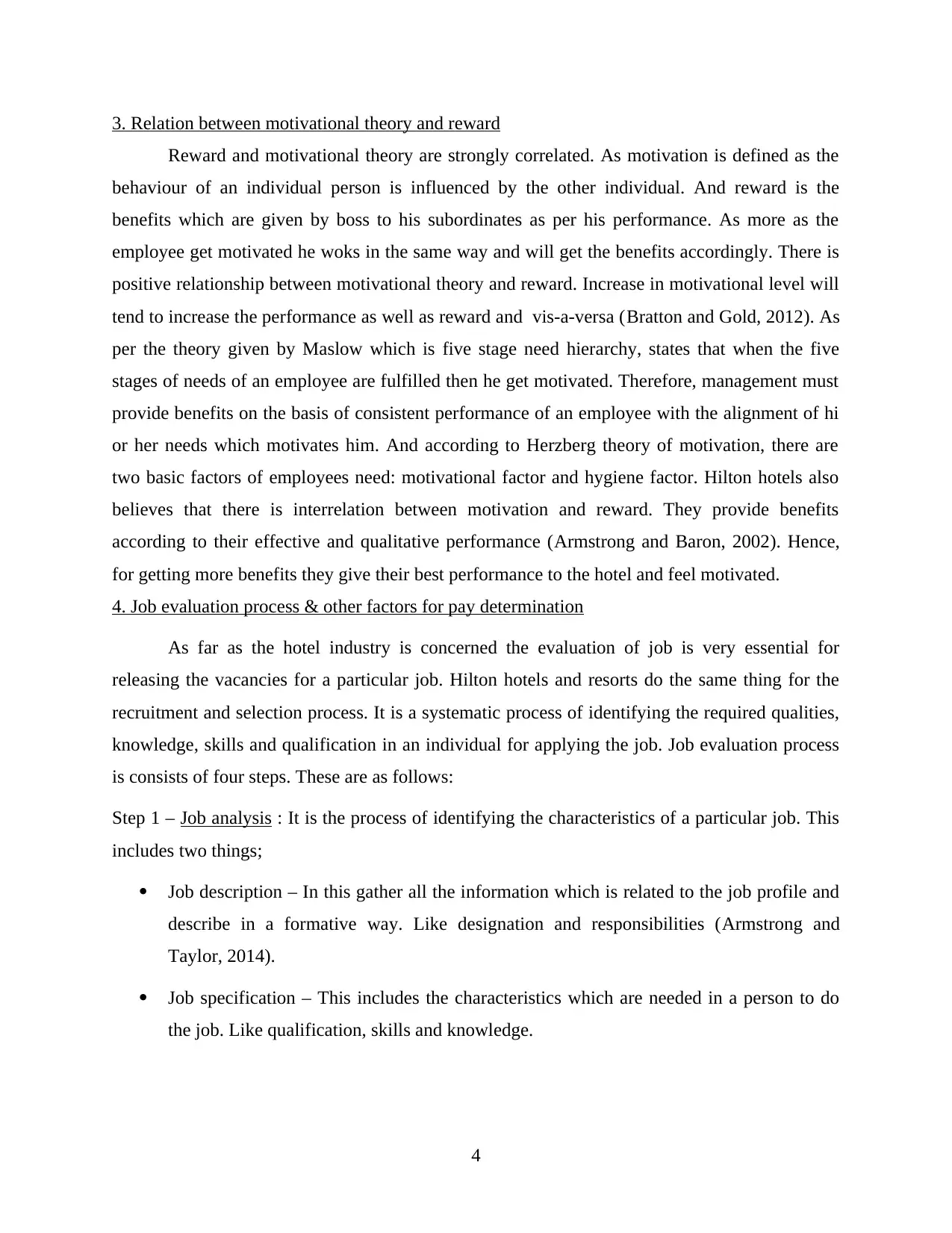
3. Relation between motivational theory and reward
Reward and motivational theory are strongly correlated. As motivation is defined as the
behaviour of an individual person is influenced by the other individual. And reward is the
benefits which are given by boss to his subordinates as per his performance. As more as the
employee get motivated he woks in the same way and will get the benefits accordingly. There is
positive relationship between motivational theory and reward. Increase in motivational level will
tend to increase the performance as well as reward and vis-a-versa (Bratton and Gold, 2012). As
per the theory given by Maslow which is five stage need hierarchy, states that when the five
stages of needs of an employee are fulfilled then he get motivated. Therefore, management must
provide benefits on the basis of consistent performance of an employee with the alignment of hi
or her needs which motivates him. And according to Herzberg theory of motivation, there are
two basic factors of employees need: motivational factor and hygiene factor. Hilton hotels also
believes that there is interrelation between motivation and reward. They provide benefits
according to their effective and qualitative performance (Armstrong and Baron, 2002). Hence,
for getting more benefits they give their best performance to the hotel and feel motivated.
4. Job evaluation process & other factors for pay determination
As far as the hotel industry is concerned the evaluation of job is very essential for
releasing the vacancies for a particular job. Hilton hotels and resorts do the same thing for the
recruitment and selection process. It is a systematic process of identifying the required qualities,
knowledge, skills and qualification in an individual for applying the job. Job evaluation process
is consists of four steps. These are as follows:
Step 1 – Job analysis : It is the process of identifying the characteristics of a particular job. This
includes two things;
Job description – In this gather all the information which is related to the job profile and
describe in a formative way. Like designation and responsibilities (Armstrong and
Taylor, 2014).
Job specification – This includes the characteristics which are needed in a person to do
the job. Like qualification, skills and knowledge.
4
Reward and motivational theory are strongly correlated. As motivation is defined as the
behaviour of an individual person is influenced by the other individual. And reward is the
benefits which are given by boss to his subordinates as per his performance. As more as the
employee get motivated he woks in the same way and will get the benefits accordingly. There is
positive relationship between motivational theory and reward. Increase in motivational level will
tend to increase the performance as well as reward and vis-a-versa (Bratton and Gold, 2012). As
per the theory given by Maslow which is five stage need hierarchy, states that when the five
stages of needs of an employee are fulfilled then he get motivated. Therefore, management must
provide benefits on the basis of consistent performance of an employee with the alignment of hi
or her needs which motivates him. And according to Herzberg theory of motivation, there are
two basic factors of employees need: motivational factor and hygiene factor. Hilton hotels also
believes that there is interrelation between motivation and reward. They provide benefits
according to their effective and qualitative performance (Armstrong and Baron, 2002). Hence,
for getting more benefits they give their best performance to the hotel and feel motivated.
4. Job evaluation process & other factors for pay determination
As far as the hotel industry is concerned the evaluation of job is very essential for
releasing the vacancies for a particular job. Hilton hotels and resorts do the same thing for the
recruitment and selection process. It is a systematic process of identifying the required qualities,
knowledge, skills and qualification in an individual for applying the job. Job evaluation process
is consists of four steps. These are as follows:
Step 1 – Job analysis : It is the process of identifying the characteristics of a particular job. This
includes two things;
Job description – In this gather all the information which is related to the job profile and
describe in a formative way. Like designation and responsibilities (Armstrong and
Taylor, 2014).
Job specification – This includes the characteristics which are needed in a person to do
the job. Like qualification, skills and knowledge.
4
⊘ This is a preview!⊘
Do you want full access?
Subscribe today to unlock all pages.

Trusted by 1+ million students worldwide
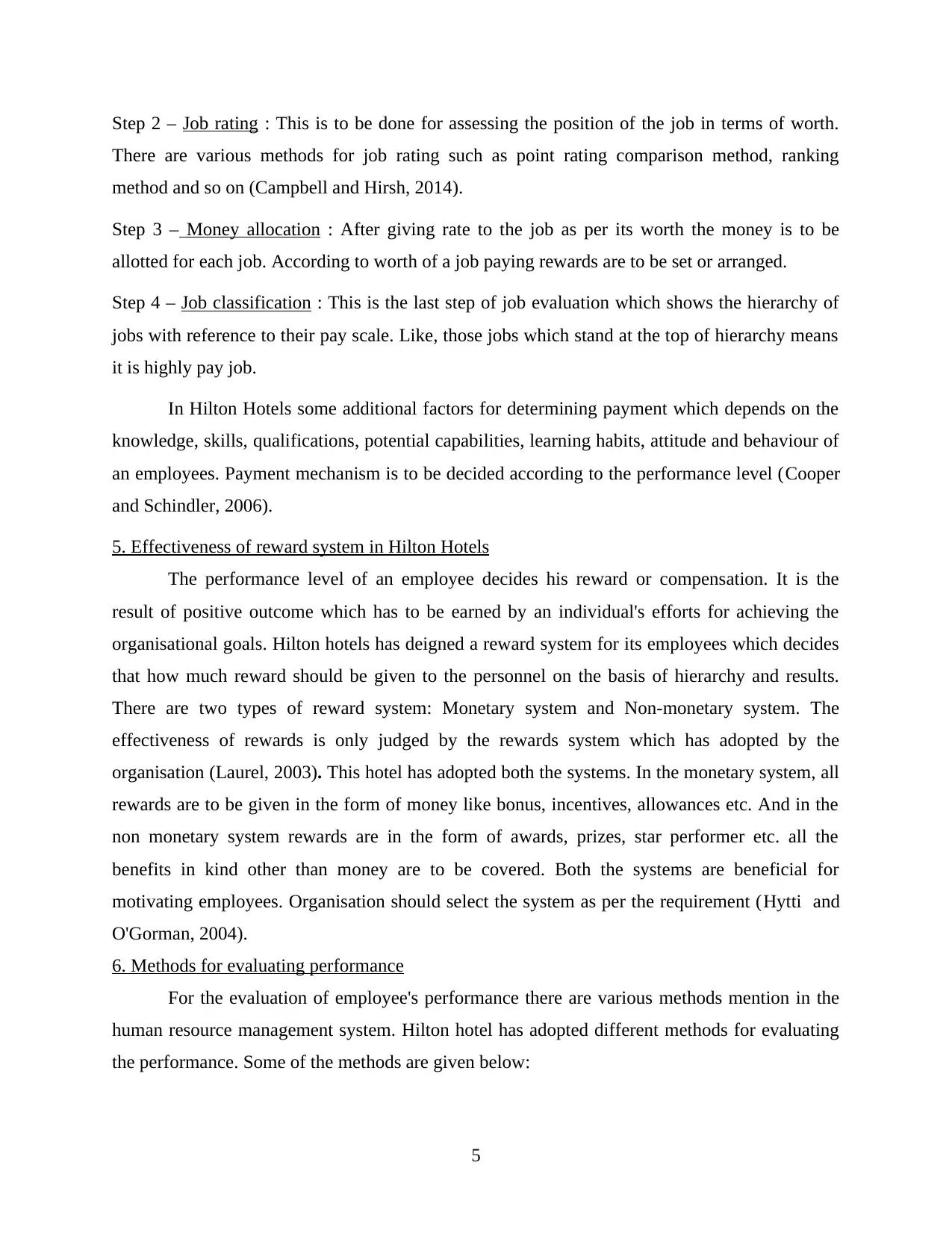
Step 2 – Job rating : This is to be done for assessing the position of the job in terms of worth.
There are various methods for job rating such as point rating comparison method, ranking
method and so on (Campbell and Hirsh, 2014).
Step 3 – Money allocation : After giving rate to the job as per its worth the money is to be
allotted for each job. According to worth of a job paying rewards are to be set or arranged.
Step 4 – Job classification : This is the last step of job evaluation which shows the hierarchy of
jobs with reference to their pay scale. Like, those jobs which stand at the top of hierarchy means
it is highly pay job.
In Hilton Hotels some additional factors for determining payment which depends on the
knowledge, skills, qualifications, potential capabilities, learning habits, attitude and behaviour of
an employees. Payment mechanism is to be decided according to the performance level (Cooper
and Schindler, 2006).
5. Effectiveness of reward system in Hilton Hotels
The performance level of an employee decides his reward or compensation. It is the
result of positive outcome which has to be earned by an individual's efforts for achieving the
organisational goals. Hilton hotels has deigned a reward system for its employees which decides
that how much reward should be given to the personnel on the basis of hierarchy and results.
There are two types of reward system: Monetary system and Non-monetary system. The
effectiveness of rewards is only judged by the rewards system which has adopted by the
organisation (Laurel, 2003). This hotel has adopted both the systems. In the monetary system, all
rewards are to be given in the form of money like bonus, incentives, allowances etc. And in the
non monetary system rewards are in the form of awards, prizes, star performer etc. all the
benefits in kind other than money are to be covered. Both the systems are beneficial for
motivating employees. Organisation should select the system as per the requirement (Hytti and
O'Gorman, 2004).
6. Methods for evaluating performance
For the evaluation of employee's performance there are various methods mention in the
human resource management system. Hilton hotel has adopted different methods for evaluating
the performance. Some of the methods are given below:
5
There are various methods for job rating such as point rating comparison method, ranking
method and so on (Campbell and Hirsh, 2014).
Step 3 – Money allocation : After giving rate to the job as per its worth the money is to be
allotted for each job. According to worth of a job paying rewards are to be set or arranged.
Step 4 – Job classification : This is the last step of job evaluation which shows the hierarchy of
jobs with reference to their pay scale. Like, those jobs which stand at the top of hierarchy means
it is highly pay job.
In Hilton Hotels some additional factors for determining payment which depends on the
knowledge, skills, qualifications, potential capabilities, learning habits, attitude and behaviour of
an employees. Payment mechanism is to be decided according to the performance level (Cooper
and Schindler, 2006).
5. Effectiveness of reward system in Hilton Hotels
The performance level of an employee decides his reward or compensation. It is the
result of positive outcome which has to be earned by an individual's efforts for achieving the
organisational goals. Hilton hotels has deigned a reward system for its employees which decides
that how much reward should be given to the personnel on the basis of hierarchy and results.
There are two types of reward system: Monetary system and Non-monetary system. The
effectiveness of rewards is only judged by the rewards system which has adopted by the
organisation (Laurel, 2003). This hotel has adopted both the systems. In the monetary system, all
rewards are to be given in the form of money like bonus, incentives, allowances etc. And in the
non monetary system rewards are in the form of awards, prizes, star performer etc. all the
benefits in kind other than money are to be covered. Both the systems are beneficial for
motivating employees. Organisation should select the system as per the requirement (Hytti and
O'Gorman, 2004).
6. Methods for evaluating performance
For the evaluation of employee's performance there are various methods mention in the
human resource management system. Hilton hotel has adopted different methods for evaluating
the performance. Some of the methods are given below:
5
Paraphrase This Document
Need a fresh take? Get an instant paraphrase of this document with our AI Paraphraser
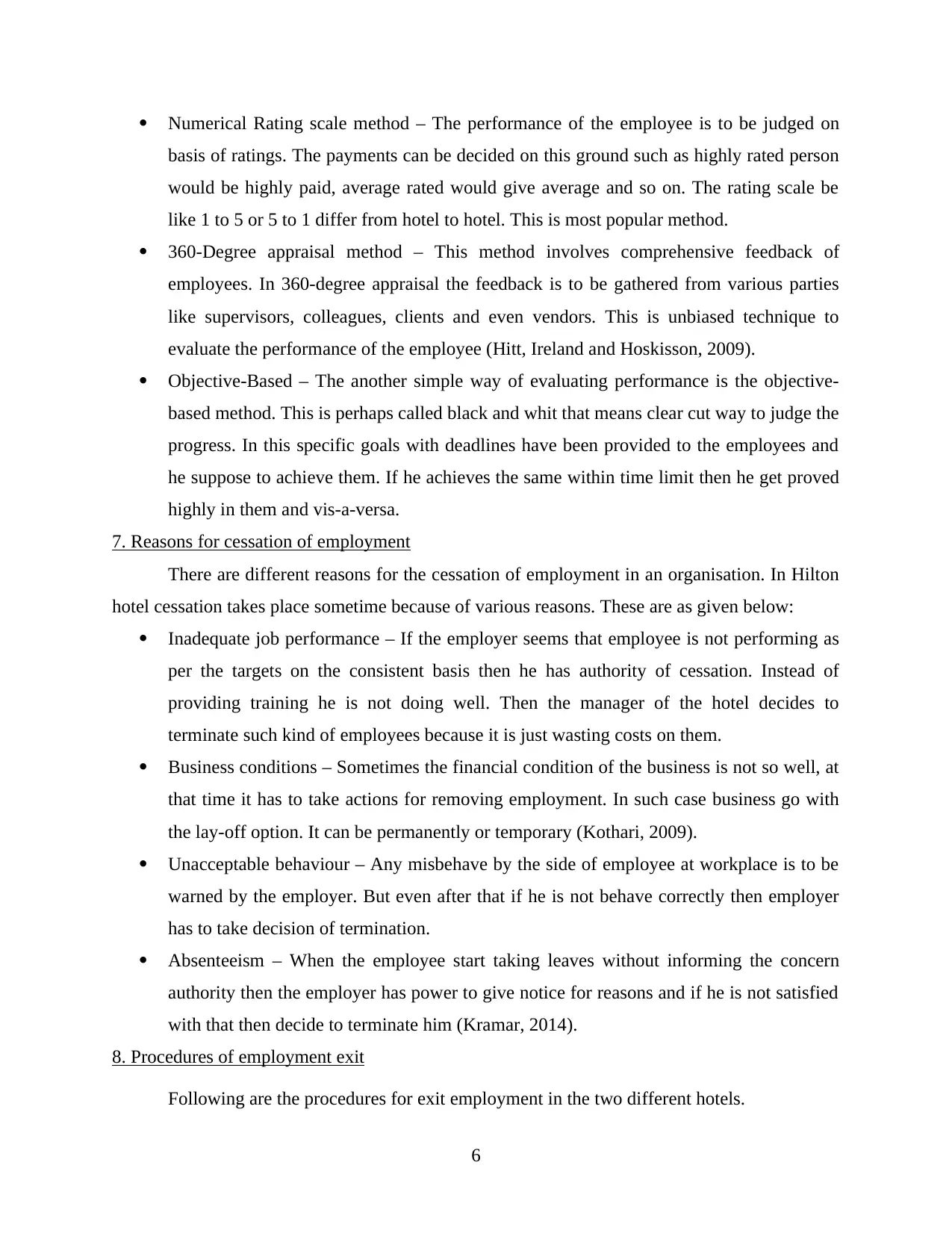
Numerical Rating scale method – The performance of the employee is to be judged on
basis of ratings. The payments can be decided on this ground such as highly rated person
would be highly paid, average rated would give average and so on. The rating scale be
like 1 to 5 or 5 to 1 differ from hotel to hotel. This is most popular method.
360-Degree appraisal method – This method involves comprehensive feedback of
employees. In 360-degree appraisal the feedback is to be gathered from various parties
like supervisors, colleagues, clients and even vendors. This is unbiased technique to
evaluate the performance of the employee (Hitt, Ireland and Hoskisson, 2009).
Objective-Based – The another simple way of evaluating performance is the objective-
based method. This is perhaps called black and whit that means clear cut way to judge the
progress. In this specific goals with deadlines have been provided to the employees and
he suppose to achieve them. If he achieves the same within time limit then he get proved
highly in them and vis-a-versa.
7. Reasons for cessation of employment
There are different reasons for the cessation of employment in an organisation. In Hilton
hotel cessation takes place sometime because of various reasons. These are as given below:
Inadequate job performance – If the employer seems that employee is not performing as
per the targets on the consistent basis then he has authority of cessation. Instead of
providing training he is not doing well. Then the manager of the hotel decides to
terminate such kind of employees because it is just wasting costs on them.
Business conditions – Sometimes the financial condition of the business is not so well, at
that time it has to take actions for removing employment. In such case business go with
the lay-off option. It can be permanently or temporary (Kothari, 2009).
Unacceptable behaviour – Any misbehave by the side of employee at workplace is to be
warned by the employer. But even after that if he is not behave correctly then employer
has to take decision of termination.
Absenteeism – When the employee start taking leaves without informing the concern
authority then the employer has power to give notice for reasons and if he is not satisfied
with that then decide to terminate him (Kramar, 2014).
8. Procedures of employment exit
Following are the procedures for exit employment in the two different hotels.
6
basis of ratings. The payments can be decided on this ground such as highly rated person
would be highly paid, average rated would give average and so on. The rating scale be
like 1 to 5 or 5 to 1 differ from hotel to hotel. This is most popular method.
360-Degree appraisal method – This method involves comprehensive feedback of
employees. In 360-degree appraisal the feedback is to be gathered from various parties
like supervisors, colleagues, clients and even vendors. This is unbiased technique to
evaluate the performance of the employee (Hitt, Ireland and Hoskisson, 2009).
Objective-Based – The another simple way of evaluating performance is the objective-
based method. This is perhaps called black and whit that means clear cut way to judge the
progress. In this specific goals with deadlines have been provided to the employees and
he suppose to achieve them. If he achieves the same within time limit then he get proved
highly in them and vis-a-versa.
7. Reasons for cessation of employment
There are different reasons for the cessation of employment in an organisation. In Hilton
hotel cessation takes place sometime because of various reasons. These are as given below:
Inadequate job performance – If the employer seems that employee is not performing as
per the targets on the consistent basis then he has authority of cessation. Instead of
providing training he is not doing well. Then the manager of the hotel decides to
terminate such kind of employees because it is just wasting costs on them.
Business conditions – Sometimes the financial condition of the business is not so well, at
that time it has to take actions for removing employment. In such case business go with
the lay-off option. It can be permanently or temporary (Kothari, 2009).
Unacceptable behaviour – Any misbehave by the side of employee at workplace is to be
warned by the employer. But even after that if he is not behave correctly then employer
has to take decision of termination.
Absenteeism – When the employee start taking leaves without informing the concern
authority then the employer has power to give notice for reasons and if he is not satisfied
with that then decide to terminate him (Kramar, 2014).
8. Procedures of employment exit
Following are the procedures for exit employment in the two different hotels.
6
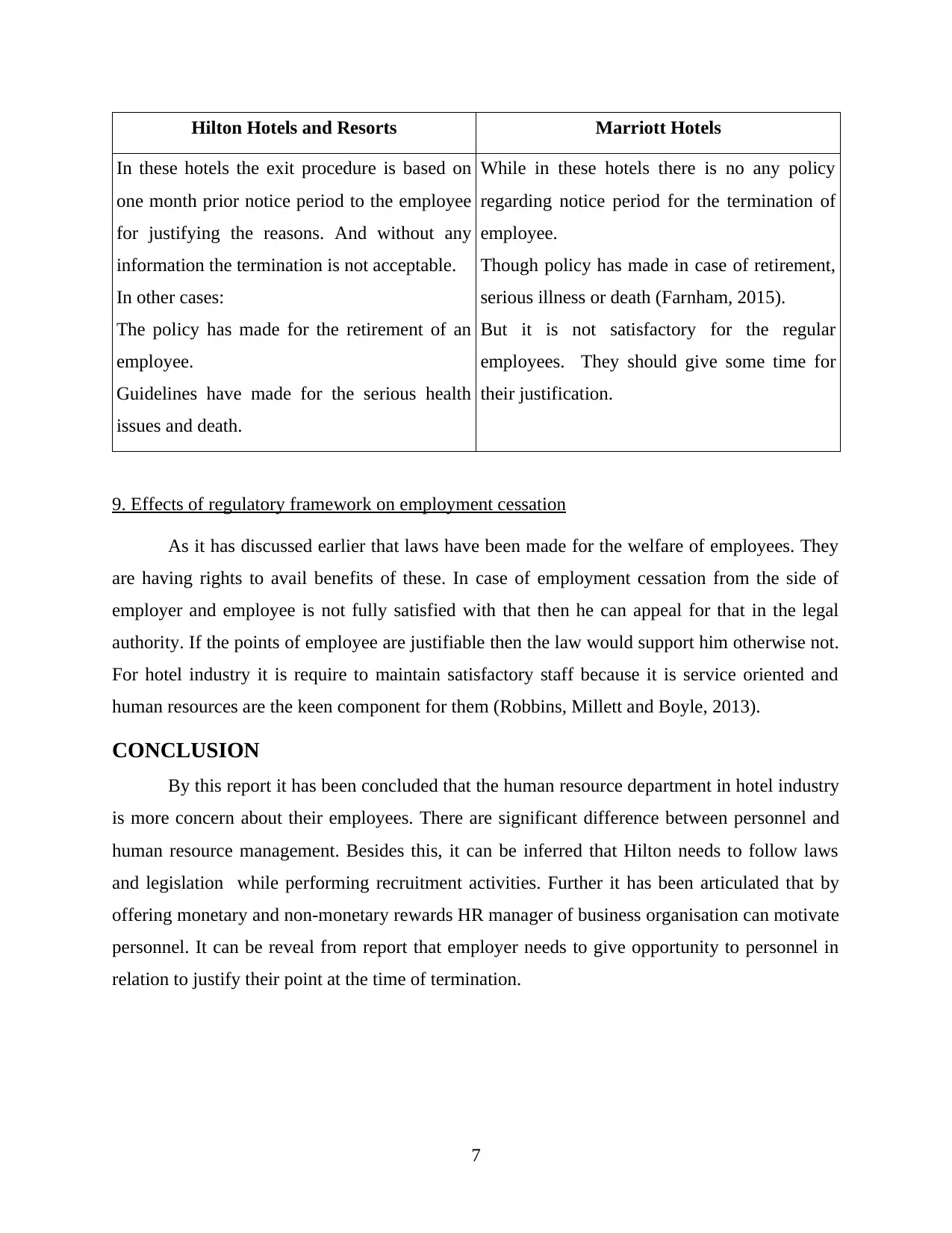
Hilton Hotels and Resorts Marriott Hotels
In these hotels the exit procedure is based on
one month prior notice period to the employee
for justifying the reasons. And without any
information the termination is not acceptable.
In other cases:
The policy has made for the retirement of an
employee.
Guidelines have made for the serious health
issues and death.
While in these hotels there is no any policy
regarding notice period for the termination of
employee.
Though policy has made in case of retirement,
serious illness or death (Farnham, 2015).
But it is not satisfactory for the regular
employees. They should give some time for
their justification.
9. Effects of regulatory framework on employment cessation
As it has discussed earlier that laws have been made for the welfare of employees. They
are having rights to avail benefits of these. In case of employment cessation from the side of
employer and employee is not fully satisfied with that then he can appeal for that in the legal
authority. If the points of employee are justifiable then the law would support him otherwise not.
For hotel industry it is require to maintain satisfactory staff because it is service oriented and
human resources are the keen component for them (Robbins, Millett and Boyle, 2013).
CONCLUSION
By this report it has been concluded that the human resource department in hotel industry
is more concern about their employees. There are significant difference between personnel and
human resource management. Besides this, it can be inferred that Hilton needs to follow laws
and legislation while performing recruitment activities. Further it has been articulated that by
offering monetary and non-monetary rewards HR manager of business organisation can motivate
personnel. It can be reveal from report that employer needs to give opportunity to personnel in
relation to justify their point at the time of termination.
7
In these hotels the exit procedure is based on
one month prior notice period to the employee
for justifying the reasons. And without any
information the termination is not acceptable.
In other cases:
The policy has made for the retirement of an
employee.
Guidelines have made for the serious health
issues and death.
While in these hotels there is no any policy
regarding notice period for the termination of
employee.
Though policy has made in case of retirement,
serious illness or death (Farnham, 2015).
But it is not satisfactory for the regular
employees. They should give some time for
their justification.
9. Effects of regulatory framework on employment cessation
As it has discussed earlier that laws have been made for the welfare of employees. They
are having rights to avail benefits of these. In case of employment cessation from the side of
employer and employee is not fully satisfied with that then he can appeal for that in the legal
authority. If the points of employee are justifiable then the law would support him otherwise not.
For hotel industry it is require to maintain satisfactory staff because it is service oriented and
human resources are the keen component for them (Robbins, Millett and Boyle, 2013).
CONCLUSION
By this report it has been concluded that the human resource department in hotel industry
is more concern about their employees. There are significant difference between personnel and
human resource management. Besides this, it can be inferred that Hilton needs to follow laws
and legislation while performing recruitment activities. Further it has been articulated that by
offering monetary and non-monetary rewards HR manager of business organisation can motivate
personnel. It can be reveal from report that employer needs to give opportunity to personnel in
relation to justify their point at the time of termination.
7
⊘ This is a preview!⊘
Do you want full access?
Subscribe today to unlock all pages.

Trusted by 1+ million students worldwide
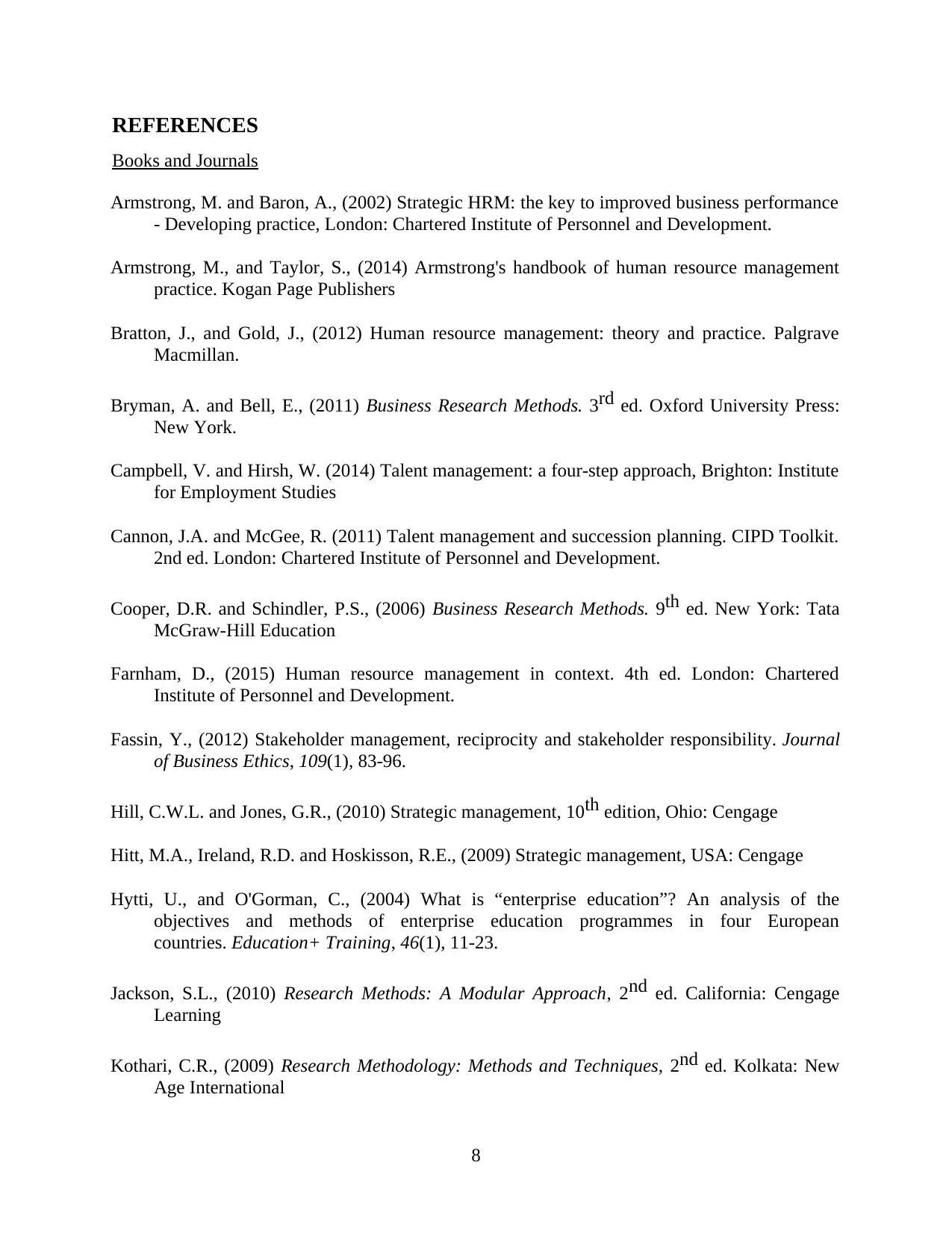
REFERENCES
Books and Journals
Armstrong, M. and Baron, A., (2002) Strategic HRM: the key to improved business performance
- Developing practice, London: Chartered Institute of Personnel and Development.
Armstrong, M., and Taylor, S., (2014) Armstrong's handbook of human resource management
practice. Kogan Page Publishers
Bratton, J., and Gold, J., (2012) Human resource management: theory and practice. Palgrave
Macmillan.
Bryman, A. and Bell, E., (2011) Business Research Methods. 3rd ed. Oxford University Press:
New York.
Campbell, V. and Hirsh, W. (2014) Talent management: a four-step approach, Brighton: Institute
for Employment Studies
Cannon, J.A. and McGee, R. (2011) Talent management and succession planning. CIPD Toolkit.
2nd ed. London: Chartered Institute of Personnel and Development.
Cooper, D.R. and Schindler, P.S., (2006) Business Research Methods. 9th ed. New York: Tata
McGraw-Hill Education
Farnham, D., (2015) Human resource management in context. 4th ed. London: Chartered
Institute of Personnel and Development.
Fassin, Y., (2012) Stakeholder management, reciprocity and stakeholder responsibility. Journal
of Business Ethics, 109(1), 83-96.
Hill, C.W.L. and Jones, G.R., (2010) Strategic management, 10th edition, Ohio: Cengage
Hitt, M.A., Ireland, R.D. and Hoskisson, R.E., (2009) Strategic management, USA: Cengage
Hytti, U., and O'Gorman, C., (2004) What is “enterprise education”? An analysis of the
objectives and methods of enterprise education programmes in four European
countries. Education+ Training, 46(1), 11-23.
Jackson, S.L., (2010) Research Methods: A Modular Approach, 2nd ed. California: Cengage
Learning
Kothari, C.R., (2009) Research Methodology: Methods and Techniques, 2nd ed. Kolkata: New
Age International
8
Books and Journals
Armstrong, M. and Baron, A., (2002) Strategic HRM: the key to improved business performance
- Developing practice, London: Chartered Institute of Personnel and Development.
Armstrong, M., and Taylor, S., (2014) Armstrong's handbook of human resource management
practice. Kogan Page Publishers
Bratton, J., and Gold, J., (2012) Human resource management: theory and practice. Palgrave
Macmillan.
Bryman, A. and Bell, E., (2011) Business Research Methods. 3rd ed. Oxford University Press:
New York.
Campbell, V. and Hirsh, W. (2014) Talent management: a four-step approach, Brighton: Institute
for Employment Studies
Cannon, J.A. and McGee, R. (2011) Talent management and succession planning. CIPD Toolkit.
2nd ed. London: Chartered Institute of Personnel and Development.
Cooper, D.R. and Schindler, P.S., (2006) Business Research Methods. 9th ed. New York: Tata
McGraw-Hill Education
Farnham, D., (2015) Human resource management in context. 4th ed. London: Chartered
Institute of Personnel and Development.
Fassin, Y., (2012) Stakeholder management, reciprocity and stakeholder responsibility. Journal
of Business Ethics, 109(1), 83-96.
Hill, C.W.L. and Jones, G.R., (2010) Strategic management, 10th edition, Ohio: Cengage
Hitt, M.A., Ireland, R.D. and Hoskisson, R.E., (2009) Strategic management, USA: Cengage
Hytti, U., and O'Gorman, C., (2004) What is “enterprise education”? An analysis of the
objectives and methods of enterprise education programmes in four European
countries. Education+ Training, 46(1), 11-23.
Jackson, S.L., (2010) Research Methods: A Modular Approach, 2nd ed. California: Cengage
Learning
Kothari, C.R., (2009) Research Methodology: Methods and Techniques, 2nd ed. Kolkata: New
Age International
8
Paraphrase This Document
Need a fresh take? Get an instant paraphrase of this document with our AI Paraphraser
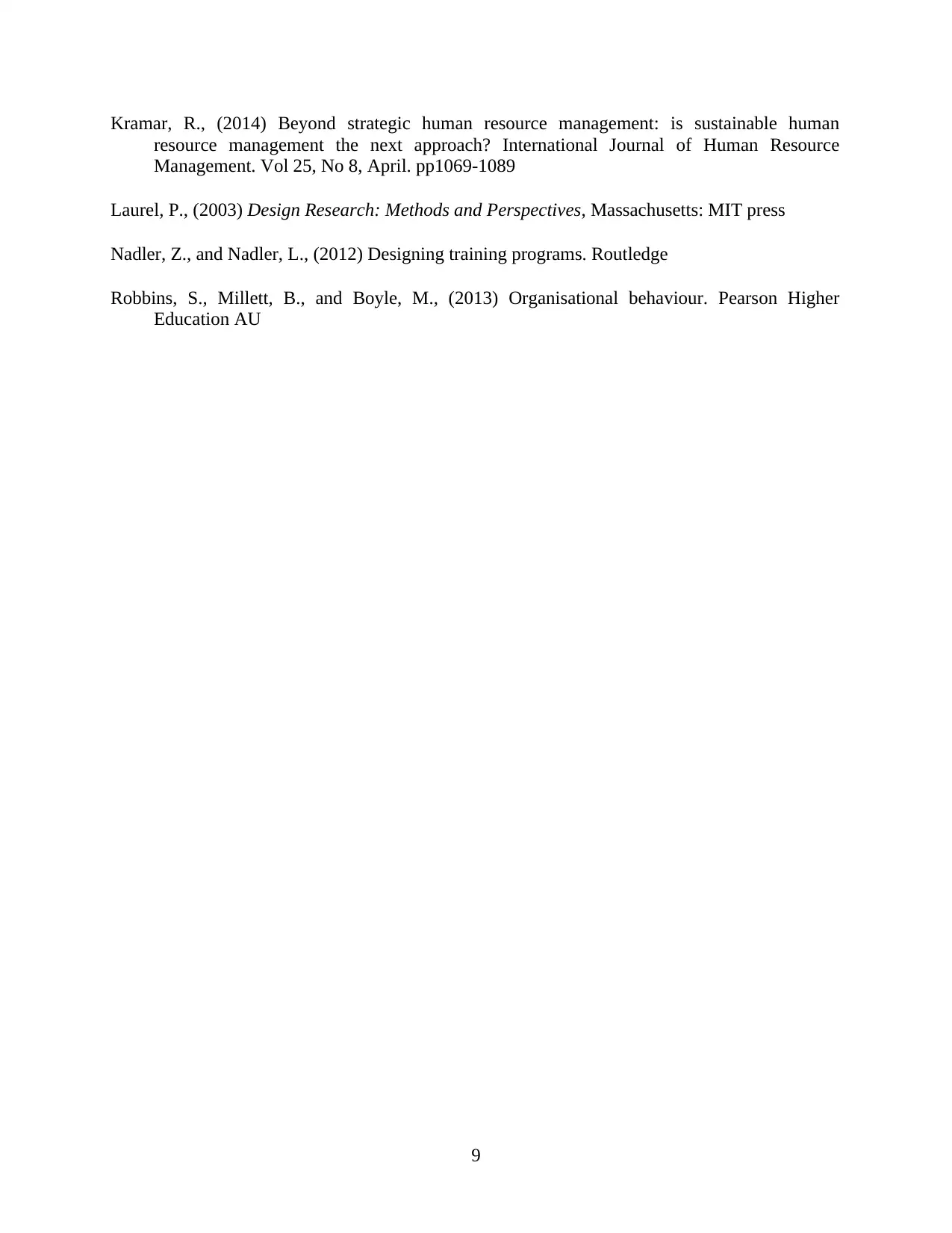
Kramar, R., (2014) Beyond strategic human resource management: is sustainable human
resource management the next approach? International Journal of Human Resource
Management. Vol 25, No 8, April. pp1069-1089
Laurel, P., (2003) Design Research: Methods and Perspectives, Massachusetts: MIT press
Nadler, Z., and Nadler, L., (2012) Designing training programs. Routledge
Robbins, S., Millett, B., and Boyle, M., (2013) Organisational behaviour. Pearson Higher
Education AU
9
resource management the next approach? International Journal of Human Resource
Management. Vol 25, No 8, April. pp1069-1089
Laurel, P., (2003) Design Research: Methods and Perspectives, Massachusetts: MIT press
Nadler, Z., and Nadler, L., (2012) Designing training programs. Routledge
Robbins, S., Millett, B., and Boyle, M., (2013) Organisational behaviour. Pearson Higher
Education AU
9
1 out of 11
Related Documents
Your All-in-One AI-Powered Toolkit for Academic Success.
+13062052269
info@desklib.com
Available 24*7 on WhatsApp / Email
![[object Object]](/_next/static/media/star-bottom.7253800d.svg)
Unlock your academic potential
Copyright © 2020–2025 A2Z Services. All Rights Reserved. Developed and managed by ZUCOL.





